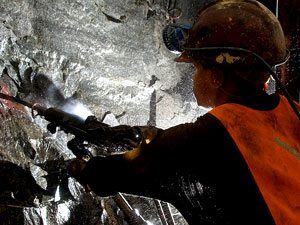
[miningmx.com] – THE astonishing observation to emerge from Impala Platinum (Implats) yesterday was not just that it was considering ditching its R11bn Leeuwkop mining project, but that it felt investors wouldn’t support another labour intensive mining development in the South African platinum sector.
That would be the long-term consequence of the strike by the Association of Mineworkers & Construction Union (AMCU) which, far from weakening, seems to be hankering for an extension of its platinum strike to gold and coal sectors.
BDLive reported today that Implats believed mechanisation represented the long-term future of the country’s platinum sector which, in a mining development like Leeuwkop, would see a labour complement of 2,000 to 3,000 people compared to a labour intensive mine employing 10,000 to 12,000 people.
“Another factor is that any new project needs to attract financing from investors,’ Johan Theron, head of Implats’ corporate affairs, told the publication.
“With labour-intensive mines struggling, it would be difficult to persuade our board or investors to finance them. In future, we will have to mine mechanised, or not at all, because labour-intensive mines will not be profitable,” he said.
BDLive also said Implats was considering partly or wholly mechanising its three new shafts — 20, 16 and 17 — at Rustenburg, which were at an advanced stage of development.
This is said to echo the strategy of Mark Cutifani, CEO of Anglo American, but it’s also a reactive strategy and puts the feasibility of Implats’ future production growth (and replacement strategy) into doubt.
Afterall, mechanisation was not the firm’s first option and rebooting a mining project to accommodate less labour risk is risky in itself. Just ask former Lonmin CEO, Brad Mills, whose tenure at the firm floundered on such decisions.
Still, one can see why mechanisation would be highly attractive to South Africa’s platinum sector, the failures of Mills notwithstanding.
Firstly, Implats must be thinking that salary demands out of whack with all reality are likely to become a long-term feature of wage negotiations; in essence, a recognition that the country’s labour representatives, or a portion of it, has radicalised.
Secondly, the maths adds up.
Crude arithmetic demonstrates that in terms of labour – and for a moment accepting AMCU’s R12,500 per month basic salary – a mechanised mine employing 3,000 people would carry a labour cost of R37.5m a month.
A labour intensive mine employing up to 10,000 people would have a labour cost of R125m, again assuming the R12,500 per month basic salary demand of AMCU.
Given that Implats told BDLive it thought Leeuwkop would cost another R1bn to mechanise, it’s possible that the platinum company could recoup the additional capital expenditure in about a year.
Of course mines planned to be labour intensive don’t just get turned into mechanised operations overnight, and the decision depends on whether the orebody is conducive to mechanisation. But with the strike 10 weeks old, management is wise to be considering its options.
As for AMCU, it’s position is moving increasingly towards militancy: its ambition to extend the strike to other sectors, for instance, and its plans to march on parliament are a definite upping of the ante.
Joseph Mathunjwa, president of AMCU, might just be guilty of rabble-rousing at a union march, but his comments are war-like. The problem with war is it’s a one-way street once declared: a kaleidoscopic perspective is swapped for a monochromatic one.
One also wonders the extent to which the South African government can intervene in the strike; what legal measures or political pressure are at hand, especially so close to national elections?
The deputy president’s mining forum, held on March 27 was simply ignored by AMCU even though it parent National Council of Trade Unions attended it.











